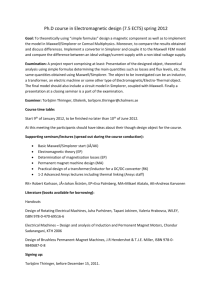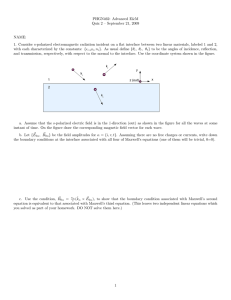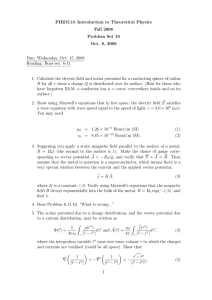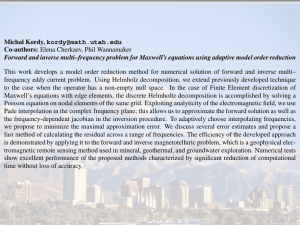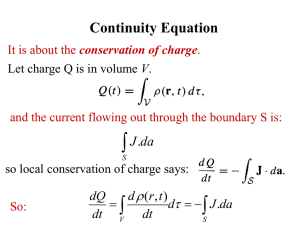Chapter 3 Maxwell`s Equation EDHB rotE = 0 divD = ρ divB = 0 rotH
advertisement
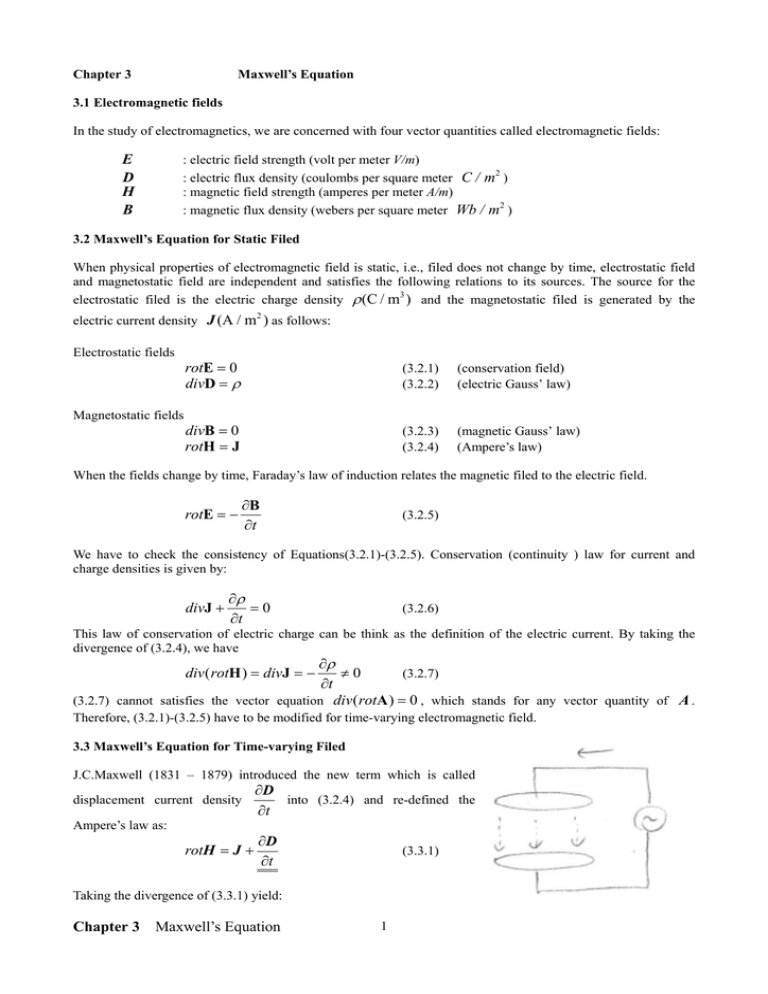
Chapter 3 Maxwell’s Equation 3.1 Electromagnetic fields In the study of electromagnetics, we are concerned with four vector quantities called electromagnetic fields: E D H B : electric field strength (volt per meter V/m) 2 : electric flux density (coulombs per square meter C / m ) : magnetic field strength (amperes per meter A/m) 2 : magnetic flux density (webers per square meter Wb / m ) 3.2 Maxwell’s Equation for Static Filed When physical properties of electromagnetic field is static, i.e., filed does not change by time, electrostatic field and magnetostatic field are independent and satisfies the following relations to its sources. The source for the 3 electrostatic filed is the electric charge density ρ (C / m ) and the magnetostatic filed is generated by the 2 electric current density J (A / m ) as follows: Electrostatic fields Magnetostatic fields rotE = 0 divD = ρ (3.2.1) (3.2.2) (conservation field) (electric Gauss’ law) divB = 0 rotH = J (3.2.3) (3.2.4) (magnetic Gauss’ law) (Ampere’s law) When the fields change by time, Faraday’s law of induction relates the magnetic filed to the electric field. rotE = − ∂B ∂t (3.2.5) We have to check the consistency of Equations(3.2.1)-(3.2.5). Conservation (continuity ) law for current and charge densities is given by: divJ + ∂ρ =0 ∂t (3.2.6) This law of conservation of electric charge can be think as the definition of the electric current. By taking the divergence of (3.2.4), we have ∂ρ (3.2.7) ≠0 ∂t (3.2.7) cannot satisfies the vector equation div ( rotA ) = 0 , which stands for any vector quantity of A . div ( rotH ) = divJ = − Therefore, (3.2.1)-(3.2.5) have to be modified for time-varying electromagnetic field. 3.3 Maxwell’s Equation for Time-varying Filed J.C.Maxwell (1831 – 1879) introduced the new term which is called displacement current density Ampere’s law as: rotH = J + ∂D into (3.2.4) and re-defined the ∂t ∂D ∂t (3.3.1) Taking the divergence of (3.3.1) yield: Chapter 3 Maxwell’s Equation 1 div ( rotH ) = divJ + ∂ρ ∂ divD = divJ + =0 ∂t ∂t (3.3.2) and it satisfies vector equation div ( rotA ) = 0 . For the time-varying electromagnetic field, all the field quantities have to satisfy the following Maxwell’s equation. ∂B ∂t ∂D rotH = J + ∂t divB = 0 divD = ρ rotE = − (3.3.3) (Faraday’s law of induction) (3.3.4) (Ampere’s law) (3.3.5) (3.3.6) (magnetic Gauss’ law) (electric Gauss’ law) It should be noted that these four equations are not independent, when we assume the continuity equation (3.2.6) is given as a definition. 3.4 Constitutive Relations Physically, the constitutive relations provide information about the environment in which electromagnetic fields occur – for example, free space, water, solid and plasma media. Mathematically, we can characterize as follows a simple medium with a permittivity ε and permeability µ . D = εE B = µH (3.4.1) (3.4.2) (3.4.1) and (3.4.2) are the constitutive relations for the simple medium. For free space, ε = ε 0 = 8.85 × 10−12 (F / m) µ = µ 0 = 4π × 10−7 (H / m) (3.4.3) (3.4.4) 3.5 Maxwell’s Equation for Time-Harmonic Fields The electromagnetic field at a single frequency can be represented by the time-harmonic fields. By using the phase notation, the electric field of time and space function can be represented by: E( x , y, z, t ) ↔ E( x , y , z) (3.5.1)) The E vector is now a complex vector, which is only a function of space. As discussed in Chapter 2, the time derivatives can be represented by jωt and the Maxwell’s equation in (3.3.3)-(3.3.6) is now rewritten as for time-harmonic fields as: rotE = − jωB rotH = J + jωD divB = 0 divD = ρ (3.5.2) (3.5.3) (3.5.4) (3.5.5) and the equation of conservation of charge (3.2.6) is given by: divJ + jωρ = 0 Chapter 3 Maxwell’s Equation (3.5.6) 2 3.6 Lorentz Force Law The Lorentz force law specifies the force acting on particle with charge q when it is moving with velocity v in an electromagnetic field characterized by E and B . F = q( E + v × B ) (3.6.1) 3.7 Poynting’s Theorem Using the vector identity H ⋅ rotE − E ⋅ rotH = div( E × H ) we find div ( E × H ) = − H ⋅ ∂B ∂D − E⋅ − J ⋅E ∂t ∂t (3.7.1) LM N OP Q ∂H ∂ 1 = H ⋅ H , we ca write ∂t ∂t 2 ∂ 1 ∂ 1 div ( E × H ) + µH ⋅ H + εE ⋅ E + J ⋅ E = 0 (3.7.2) ∂t 2 ∂t 2 Using the constitutive relations and noticing that H ⋅ FG H IJ K FG H IJ K 3 Note that each term in the above equation has the unit Watts / m . J ⋅E (3.6.4) 1 U E = εE ⋅ E 2 1 U H = µH ⋅ H 2 S = E×H the power lost per unit volume by the electric field to heat (3.7.3) Stored electric energy (3.7.4) Stored magnetic energy (3.7.5) Poynting vector (3.7.2) shows the conservation of power. The Poynting vector represents flow of electromagnetic power per unit area. For time-harmonic electromagnetic fields, the time-average Poynting’s vector the time-domain Pyinting vector S( x , y , z , t ) over a period T = 1 S = 2π z 2π E ( x , y , z , t ) × H ( x , y , z , t )dωt ω . (3.7.6) 0 From section 1.3, we conclude that S = 2π l q 1 Re E × H * 2 Chapter 3 Maxwell’s Equation (3.7.7) 3 S is defined as the average of
